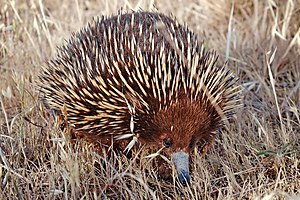Australosphenida
| Australosphenida | ||||||||||||
|---|---|---|---|---|---|---|---|---|---|---|---|---|

Short-billed hedgehog ( Tachyglossus aculeatus ) |
||||||||||||
| Temporal occurrence | ||||||||||||
| Middle Jurassic until today | ||||||||||||
| 165 to 0 million years | ||||||||||||
| Locations | ||||||||||||
| Systematics | ||||||||||||
|
||||||||||||
| Scientific name | ||||||||||||
| Australosphenida | ||||||||||||
| Luo , Cifelli , & Kielan-Jaworowska , 2001 | ||||||||||||
The Australosphenida are a subgroup of mammals . The name is made up of Austral , for south, and Sphenida, alluding to the Tribosphenida , i.e. those mammals with a tribosphenic tooth structure . The name Australosphenida goes back to a work by Zhexi Luo and co-workers from 2001, in which the authors argue that the tribosphenic tooth structure in mammals developed convergent twice, once in the ancestors of modern mammals, the Theria , in the northern one Hemisphere (referred to as Boreosphenida by Luo et al. ), And once in the line of development that ultimately led to the Monotrematen (egg-laying mammals). The latter line has so far been limited to the southern hemisphere ( Gondwana ) and was therefore named Australosphenida. This theory was originally very controversial, but has been corroborated in recent years by new fossil discoveries , in particular by the detailed study of the basal australosphenid Asfaltomylos from the Middle Jurassic of Patagonia .
Anatomical differences to borosphenids
Despite the very similar tooth structure, the Australospheniden differ in numerous features from the Boreospheniden. So is z. B. the lower jaw is still very primitive and consists of more than one bone per side. The mandibular teeth have a prominent anterior cingulum and a talonid that is wider than it is long. The traces of wear on the lower teeth also allow the conclusion that a real protocon , an important structural element of the upper teeth in the Theria, is missing. New finds of the primitive monotremer Teinolophos from the Lower Cretaceous of Australia also indicate that the structure of the middle ear in the Australosphenida and Boreosphenida also emerged independently of one another.
Fossil record
The Australosphenida fossil record is still very poor. The oldest known representative of the Australosphenida is Ambondro from the Middle Jurassic ( Bathonium ) of Madagascar , of which only teeth and a jaw fragment have so far been found. The relationships of the Australosphenida within the mammals indicate, however, that they represent a very early split from the line that leads to the Theria, so that their origin may already be found in the Upper Triassic . The most basal known representative, Asfaltomylos , from Argentina , of which a lower jaw with almost complete dentition is known, is only a little younger ( Callovium ) than Ambondro . Two groups of Australosphenida are documented from the Lower Cretaceous of Australia, the Ausktribosphenida and the first Monotrematen, Steropodon and Teinolophos . Since the Cretaceous period, the fossil record of the Australosphenida has been limited almost exclusively to Australia, only from the Paleocene of Argentina are there still very fragmentary finds of monotremes ( genus Monotrematum ). Practically complete remains of monotremes are only known from the Miocene of the important Australian site Riversleigh .
literature
- JJ Flynn, JM Parrish, B. Rakotosamimanana, WF Simpson, AR Wyss: A Middle Jurassic mammal from Madagascar. In: Nature 401, 1999, pp. 57-60.
- Z.-X. Luo, RL Cifelli, Z. Kielan-Jaworowska: Dual origin of tribosphenic mammals. In: Nature 409, 2001, pp. 53-57.
- Z.-X. Luo, Z. Kielan-Jaworowska, RL Cifelli: In quest for a phylogeny of Mesozoic mammals. In: Acta Palaeontologica Polonica 47, Heft 1, 2002, pp. 1-78.
- T. Martin, Z.-X. Luo: Homoplasy in the mammalian ear. In: Science 307, 2005, pp. 861-862.
- T. Martin, OWM Rauhut: Mandible and dentition of Asfaltomylos patagonicus (Australosphenida, Mammalia) and the evolution of tribosphenic teeth. In: Journal of Vertebrate Paleontology 25, Issue 2, 2005, pp. 414-425.
- R. Pascual, M. Archer, E. Ortiz Jaureguizar, JL Prado, H. Godthelp, SJ Hand: The first non-australian monotreme: an early Paleocene South American Platypus (Monotremata, Ornithorhynchidae) . In: ML Augee (Ed.): Platypus and echidnas . The Royal Society of New South Wales, Sydney 1992, pp. 2-15.
- OWM Rauhut, T. Martin, E. Ortiz-Jaureguizar, P. Puerta: A Jurassic mammal from South America. In: Nature 416, 2002, pp. 165-168.
- TH Rich, P. Vickers-Rich, A. Constantine, TF Flannery, L. Kool, N. v. Pianos: Early Cretaceous mammals from Flat Rocks, Victoria, Australia. In: Records of the Queen Victoria Museum 106, 1999, pp. 1-35.
- TH Rich, P. Vickers-Rich, P. Trusler, TF Flannery, R. Cifelli, A. Constantine, L. Kool, N. v. Klaveren: Monotreme nature of the Australian Early Cretaceous mammal Teinolophos . In: Acta Palaeontologica Polonica 46, Heft 1, 2001, pp. 113-118.